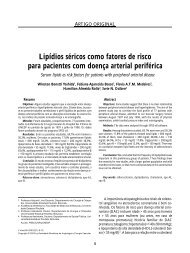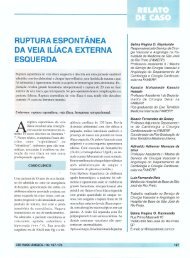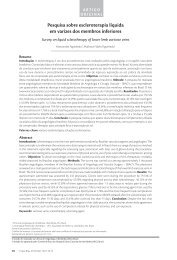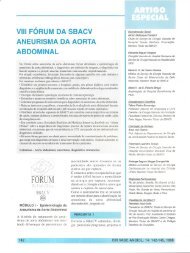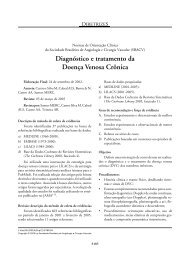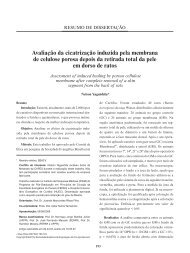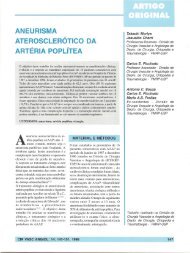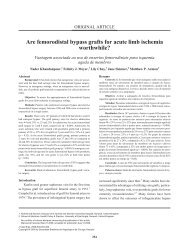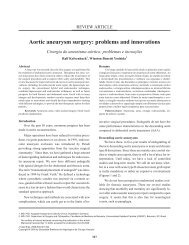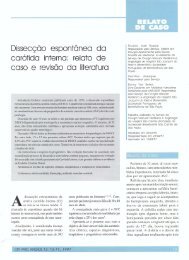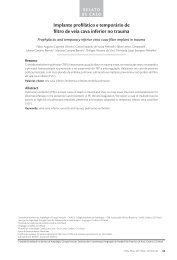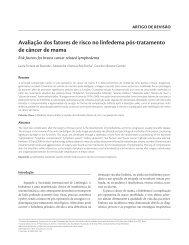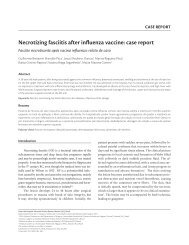Atrial embolism of floating thrombus of the great saphenous vein ...
Atrial embolism of floating thrombus of the great saphenous vein ...
Atrial embolism of floating thrombus of the great saphenous vein ...
Create successful ePaper yourself
Turn your PDF publications into a flip-book with our unique Google optimized e-Paper software.
258J Vasc Bras 2010, Vol. 9, Nº 4<strong>Atrial</strong> <strong>embolism</strong> after micr<strong>of</strong>oam ultrasound-guided sclero<strong>the</strong>rapy - Lopes RPF et al.normal sinus rhythm. At physical examination, a dilatedand pulsatile <strong>great</strong>er <strong>saphenous</strong> <strong>vein</strong> (GSV) at <strong>the</strong> saphen<strong>of</strong>emoraljunction (SFJ) on both lower limbs was observed(Figure 1). Preoperative duplex ultrasound showed <strong>the</strong>right saphen<strong>of</strong>emoral junction with 15 mm in diameter,dilatation and reflux in all <strong>the</strong> length <strong>of</strong> <strong>the</strong> GSV and invaricose tributary <strong>vein</strong>s, as well as a patent and competentdeep venous system.The procedure was performed in supine position anda tourniquet at <strong>the</strong> level <strong>of</strong> <strong>the</strong> patient’s knee. The <strong>great</strong>er<strong>saphenous</strong> <strong>vein</strong> was punctured with Jelco 18-gauge needleat <strong>the</strong> distal portion <strong>of</strong> <strong>the</strong> thigh using Doppler ultrasoundguidance. Micr<strong>of</strong>oam was prepared by mixing polidocanol3% and room air in a 1:4 proportion (Tessari method);afterwards, 8 mL <strong>of</strong> this solution was injected under realtimeultrasound guidance, while <strong>the</strong> limb was kept in a45-degree elevation and <strong>the</strong> saphen<strong>of</strong>emoral junction wasFigure 1 - Dilated, visible and pulsatile <strong>great</strong> <strong>saphenous</strong> <strong>vein</strong> at physicalexamination <strong>of</strong> <strong>the</strong> right thighcompressed by an ultrasound transducer. The right lowerlimb and <strong>the</strong> saphen<strong>of</strong>emoral junction were maintained in<strong>the</strong> same position for ten minutes and, <strong>the</strong>n, <strong>the</strong> whole limbwas wrapped with a compression inelastic bandage for 24hours. There were no intercurrences during <strong>the</strong> procedure,and elastic stockings (30-40 mmHg <strong>of</strong> pressure) were prescribedfor 30 days.The patient returned seven days after <strong>the</strong> procedurewith clear subjective clinical improvement. Follow-upDoppler ultrasound showed total occlusion <strong>of</strong> <strong>the</strong> <strong>great</strong>er<strong>saphenous</strong> <strong>vein</strong> in <strong>the</strong> two distal thirds <strong>of</strong> <strong>the</strong> thigh. Theproximal segment <strong>of</strong> <strong>the</strong> <strong>great</strong> <strong>saphenous</strong> <strong>vein</strong> was partiallyoccluded, and Doppler ultrasound also showed a <strong>floating</strong><strong>thrombus</strong> in <strong>the</strong> saphen<strong>of</strong>emoral junction, that fragmentedduring <strong>the</strong> ultrasound examination. There were no signs <strong>of</strong>deep venous thrombosis (DVT). The <strong>thrombus</strong> was immediatelyidentified ascending <strong>the</strong> inferior vena cava, and immediately<strong>the</strong>reafter, transthoracic echocardiogram showeda <strong>floating</strong> embolus in <strong>the</strong> right atrium (Figure 2). The patientwas placed in left lateral decubitus position and sentto <strong>the</strong> Intensive Care Unit. The absence <strong>of</strong> thrombi on <strong>the</strong>saphen<strong>of</strong>emoral junction allowed emergency ligation-division<strong>of</strong> <strong>the</strong> <strong>great</strong>er <strong>saphenous</strong> <strong>vein</strong>, under local anes<strong>the</strong>sia.Anticoagulation <strong>the</strong>rapy with unfractionated heparin wasinitiated. At repeat transthoracic echocardiogram two dayslater, <strong>the</strong> embolus was no longer seen. Arterial blood gaswas normal and helical CT scan showed no signs <strong>of</strong> pulmonary<strong>embolism</strong> (PE). The patient was found to be asymptomaticand was discharged after five days on warfarinfor outpatient follow-up and anticoagulation control. Noevidence <strong>of</strong> DVT or PE was detected six months after <strong>the</strong>procedure and <strong>the</strong> anticoagulation <strong>the</strong>rapy was terminated.Informed consent was obtained from <strong>the</strong> patient in order toreport this case.DiscussionFigure 2 - Trans-thoracic echocardiogram showing <strong>floating</strong> embolus in<strong>the</strong> right atriumMS is a promising <strong>the</strong>rapeutic procedure that has beenradically changing <strong>the</strong> management <strong>of</strong> varicose <strong>vein</strong>s 1,2 . Theadoption <strong>of</strong> fast micr<strong>of</strong>oam preparation systems and routineguidance by Doppler ultrasound have increased <strong>the</strong> interestin <strong>the</strong> method, which may be performed in outpatientclinics without anes<strong>the</strong>sia in one or more sessions, besidesresulting in a shorter recovering period in comparison toclassic surgery 1,3,4 . Virtually all kinds <strong>of</strong> varicose <strong>vein</strong>s canbe treated even when <strong>the</strong> conventional surgical treatmenthas limitations, includind instances in which conventionalsurgical treatment present limitations, such as patients <strong>of</strong>functional classifications CEAP C4, C5 and C6, recurrent
<strong>Atrial</strong> <strong>embolism</strong> after micr<strong>of</strong>oam ultrasound-guided sclero<strong>the</strong>rapy - Lopes RPF et al. J Vasc Bras 2010, Vol. 9, Nº 4 259varicose <strong>vein</strong>s and high surgical risk patients 3,4 . The number<strong>of</strong> publications on <strong>the</strong> method is increasing, but <strong>the</strong>re is stillno consensus regarding indications and contraindications,technical variations and <strong>the</strong> rate <strong>of</strong> complications 5,6 .The efficacy and safety <strong>of</strong> <strong>the</strong> method have been emphasizedby many studies 1,3,6 , but only a relatively smallnumber <strong>of</strong> complications, <strong>of</strong>ten not severe, has been published1,2,4 . However, <strong>the</strong> actual incidence <strong>of</strong> complicationsis unknown 2 , and potentially severe and lethal events havealready been described, including <strong>the</strong> rare and well-documentedcase <strong>of</strong> stroke in a patient with an 18-mm patentoval foramen and left shunt 7 , and a case <strong>of</strong> cardiorespiratoryarrest associated with polidocanol sclero<strong>the</strong>rapy forvenous malformation in a child with Klippel-Trenaunaysyndrome 8 .Extravasation <strong>of</strong> <strong>the</strong> sclerosing agent into <strong>the</strong> deep venoussystem through perforating <strong>vein</strong>s or at <strong>the</strong> saphen<strong>of</strong>emoraljunction during <strong>the</strong> procedure may be responsiblefor some <strong>of</strong> <strong>the</strong>se complications. Some ways <strong>of</strong> avoiding ithave been described, including digital compression or ultrasonographicmonitoring during sclerosing agent injection1,9,10 . A prospective, controlled and randomized trialsuggested that SFJ ligature under local anes<strong>the</strong>sia prior to<strong>the</strong> GSV sclero<strong>the</strong>rapy increases <strong>the</strong> procedure safety bylimiting <strong>the</strong> extravasation 11 . Recently, Bidwai et al. proposeda clipping ligature <strong>of</strong> <strong>the</strong> perforating <strong>vein</strong>s under local anes<strong>the</strong>siaafter locating <strong>the</strong>m by means <strong>of</strong> Doppler ultrasoundand SFJ monitoring by Fogarty balloon ca<strong>the</strong>ter 12 .Delayed major complications are rare and almost exclusivelypresent as venous thrombosis, which is <strong>of</strong>ten asymptomaticand diagnosed by Doppler ultrasound within 7 to14 days after <strong>the</strong> procedure 2,4 . DVT is commonly limited to<strong>the</strong> calf muscular <strong>vein</strong>s or tibial <strong>vein</strong>s. Femoral or poplitealDVT rarely occurs by direct extension <strong>of</strong> thrombosis from<strong>the</strong> saphen<strong>of</strong>emoral/saphenopopliteal junctions or perforating<strong>vein</strong>s 9,10 . A large prospective multicenter study <strong>of</strong> 12,173sclero<strong>the</strong>rapy sessions reported one single case <strong>of</strong> femoralDVT and no case <strong>of</strong> <strong>embolism</strong> 2 . Yamaki et al. reporteda DVT case with symptomatic PE after ligature <strong>of</strong> <strong>the</strong> <strong>great</strong><strong>saphenous</strong> <strong>vein</strong> associated with polidocanol sclero<strong>the</strong>rapy 13 .Compression <strong>of</strong> <strong>the</strong> limb after sclero<strong>the</strong>rapy reduces<strong>the</strong> pathological reflow and <strong>the</strong> diameter <strong>of</strong> <strong>the</strong> treated <strong>vein</strong>,besides reducing <strong>the</strong> DVT risk 3 . It should be performed immediatelyafter <strong>the</strong> <strong>the</strong>rapy session in all patients. However,<strong>the</strong>re are nei<strong>the</strong>r consensus about <strong>the</strong> ideal compressionmethod and duration nor studies that confirm its unquestionablerelevance as an adjuvant to sclero<strong>the</strong>rapy 3,5,6 . In ourcase, it is probable that <strong>the</strong> wide diameter <strong>of</strong> <strong>the</strong> saphen<strong>of</strong>emoraljunction, associated with <strong>the</strong> pulsatility resultingfrom CHF and <strong>the</strong> difficulty in maintaining compressionafter <strong>the</strong> procedure have contributed to non-obliteration <strong>of</strong><strong>the</strong> <strong>great</strong> <strong>saphenous</strong> <strong>vein</strong> and <strong>the</strong> local <strong>floating</strong> <strong>thrombus</strong>formation. Although <strong>the</strong>re are not studies that determine amaximal acceptable diameter <strong>of</strong> <strong>the</strong> saphen<strong>of</strong>emoral junctionfor use <strong>of</strong> this method, <strong>the</strong> present clinical observationmay limit its indication for patients with wide SFJ and reducepossible complications.ConclusionMS is a promising treatment for varicose <strong>vein</strong>s becauseit is a simple, easily reproducible, less invasive, cost-effectiveand safe method 11 . However, it can rarely result in severecomplications like those reported in this paper. Someprecautions such as <strong>the</strong> patient careful selection, choice<strong>of</strong> <strong>the</strong> sclerosing agent and <strong>of</strong> <strong>the</strong> puncture site, compressive<strong>the</strong>rapy and <strong>the</strong> experience <strong>of</strong> <strong>the</strong> physician with o<strong>the</strong>rmethods <strong>of</strong> sclero<strong>the</strong>rapy – as well as his ability to diagnoseand treat possible complications – may increase <strong>the</strong> efficacyand safety <strong>of</strong> this procedure 3 .References1. Redondo P, Cabrera J. Micr<strong>of</strong>oam sclero<strong>the</strong>rapy. Semin Cutan MedSurg. 2005;24:175-83.2. Guex JJ, Allaert FA, Gillet JL, Chleir F. Immediate and midtermcomplications <strong>of</strong> sclero<strong>the</strong>rapy: report <strong>of</strong> a prospective multicenterregistry <strong>of</strong> 12,173 sclero<strong>the</strong>rapy sessions. Dermatol Surg.2005;31:123-28.3. Zimmet SE. Sclero<strong>the</strong>rapy treatment <strong>of</strong> telangiectasias and varicose<strong>vein</strong>s. Tech Vasc Interv Radiol. 2003;6:116-20.4. Munavalli GS, Weiss RA. Complications <strong>of</strong> sclero<strong>the</strong>rapy. SeminCutan Med Surg. 2007;26:22-8.5. Breu FX, Guggenbichler S. European Consensus Meeting on FoamSclero<strong>the</strong>rapy, April, 4-6, 2003, Tegernsee, Germany. Dermatol Surg.2004;30:709-17.6. Rabe E, Pannier-Fischer F, Gerlach H, Breu FX, Guggenbichler S,Zabel M; German Society <strong>of</strong> Phlebology. Guidelines for sclero<strong>the</strong>rapy<strong>of</strong> varicose <strong>vein</strong>s (ICD 10: I83.0, I83.1, I83.2 and I83.9). DermatolSurg. 2004;30:687-93.7. Forlee MV, Grouden M, Moore DJ, Shanik G. Stroke after varicose<strong>vein</strong> foam injection sclero<strong>the</strong>rapy. J Vasc Surg. 2006;43:162-4.8. Marrocco-Trischitta MM, Guerrini P, Abeni D, Stillo F. Reversiblecardiac arrest after polidocanol sclero<strong>the</strong>rapy <strong>of</strong> peripheral venousmalformation. Deramtol Surg. 2002;28:153-5.9. Smith PC. Chronic venous disease treated by ultrasoundguided foam sclero<strong>the</strong>rapy. Eur J Vasc Endovasc Surg. 2006;32:577-83.10. O’Hare JL, Earnshaw JJ. The use <strong>of</strong> foam sclero<strong>the</strong>rapy for varicose <strong>vein</strong>s:a survey <strong>of</strong> <strong>the</strong> members <strong>of</strong> <strong>the</strong> Vascular Society <strong>of</strong> Great Britain andIreland. Eur J Vasc Endovasc Surg. 2007;34: 232-5.



